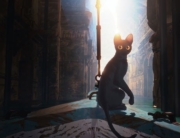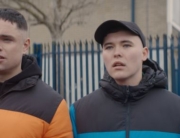Art is as much a form of entertainment as it is therapy, a way to animate what troubles us, if only to make trauma less excruciating. For German-Jewish artist Charlotte Salomon, it was her outlet, crafting more than a thousand paintings detailing the fears and hopes of someone living in Nazified Europe. This story has been told several times before on film, on the page, and in the opera house, but with Charlotte, Salomon’s tragedy is brought to life via animation in her signature watercolor style. It doesn’t go anywhere beyond your standard biopic structure, but the visuals certainly convey her work and life.
From childhood to her heartbreaking murder in Auschwitz at age 26, art and tragedy are the constants of Salomon’s life. A master of the brush growing up, art calms Salomon (voiced by Keira Knightley; Marion Cotillard in the French language version) and helps her see the beauty in small moments. In 1933 Germany, it was enough to earn her a spot in an esteemed art academy, despite rising prejudice against Jews by the newly formed Third Reich government. In this moment, everyone in her family lives as normal a life as possible: her physician father Albert, her stepmother Paula, even her grandparents, whose trip to the Sistine Chapel only accentuates her passion for art. All sense danger but have yet to fathom how bad it will become.
Early on, a gang of Hitler Youths interrupting Paula’s recital—with the whole family in attendance—is dismissed by the conductor as rabble-rousers. But years later, Salomon is quickly dropped from the school and a falling out with her lover, Alfred Wolfson (Mark Strong), coincides with the horrific destruction of Kristallnacht. Eventually her father too is brutalized by the Nazi government and, realizing that normality is all but impossible anymore, sends his daughter to live with Grosspapa and Grossmama in the South of France. There, she finds solace in the housing provided by wealthy American-born patron Ottilie Moore (Sophie Okonedo), as well as a new love, groundskeeper Alexander Nagler (Sam Claflin), and her art continues to flourish. But this cannot last, as the risks of harm and emotional anxiety begin lurking as much as from the Nazis as the strain of her own family. As the Nazi’s grip over Europe tightens, her grandparents’ inner demons become more pronounced: Grossmama succumbs to suicidal tendencies and Grosspapa’s curmudgeonly attitude morphs into outright cruelty. It’s a bubble of tragedy and, while Salomon finds love in-between, it’s her ability to commit memory to brushstroke that offers a lifeline.
Charlotte attempts to mask a Holocaust-era setting with intimate moments of happiness spun through its gorgeous 2D animation. A collaboration between studios January Films, Les Productions Balthazar, and Walking the Dog, each shot is simplistic yet stylized, casting us into Salomon’s shoes through the gouaches art style that defined her canvases. They’re picturesque and haunting at the same time, traits that would eventually be applied to Salomon’s post-mortem art book Leben? oder Theater (translation: Life? or Theater), widely regarded as one of the original examples of a graphic novel.
While Charlotte’s strengths are its visuals and Knightley’s performance, the story feels safe by comparison. This is a biopic tale, so the story line mostly bounces from one life event to the next, detailing Salomon’s understanding of key historical horror but never showing more substance. Her emotions are conveyed through the animation, most notably in scenes designed to resemble watercolor paintings drawn in real-time. Yet by and large, the animation offers a grounded tale, rather than distort its world for heightened emotional awareness. It also sidesteps details about Salomon’s contempt for her grandfather, who, according to records, tormented her through verbal and implied sexual abuse, making their falling out here seem more out of left field than hauntingly grotesque.
Clocking in at just over an hour and a half, Charlotte provides exactly what it sets out to deliver as an animated feature for adults. You’ll see all the highs and lows of Salomon’s melancholic, artistic life without having to endure the final part: being murdered, five months pregnant, in the heart of Nazi evil. The most solace we can take is that her memories live on through her images, her art.
Charlotte Salomon left behind 769 pieces of artwork that survived the Nazi’s cruelty. Her murderers are either dead or forgotten, but through these paintings, her story lives on.







Leave A Comment